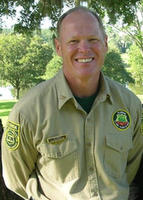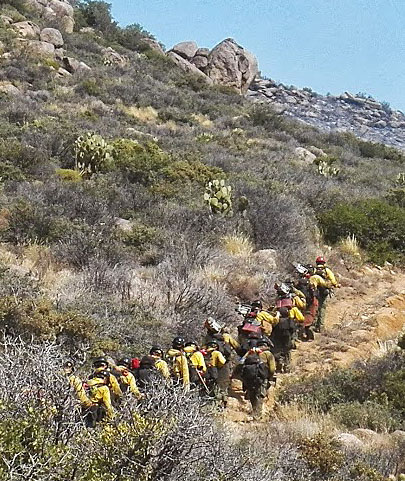
The person who led the 54-person team that investigated the June 30 deaths of 19 members of the Granite Mountain Hotshots talked to a reporter for the Florida Current about the results of their investigation and how they track firefighters in his agency.
Previously, Florida State Forester Jim Karels’ team wrote in their report about the Yarnell Hill Fire which was released in September:
The judgments and decisions of the incident management organizations managing this fire were reasonable. Firefighters performed within their scope of duty, as defined by their respective organizations. The Team found no indication of negligence, reckless actions, or violations of policy or protocol.
The Yarnell Hill Fire report also said:
… [it] does not identify causes in the traditional sense of pointing out errors, mistakes, and violations…
Many of us criticized the report for whitewashing the tragedy and failing firefighters who deserve to increase their knowledge of how to avoid similar disasters in the future. A lessons learned opportunity was missed.
It will be interesting to see if the report about the fire that is being written by the Arizona Division of Occupational Safety and Health provides better information about what happened, why, and how to avoid similar deaths.
Below is an excerpt from the article in the Florida Current:
Karels, though, said a second section of the report asks questions about the decision-making process that will help develop lessons to be learned. He said the fact that all 19 firefighters died together while making decisions on their own and separately made the investigation different from other investigations.
“It would be real easy to say, ‘This is exactly what happened and these are why decisions were made and this is something to blame,'” Karels said. “But all 19 are gone. So we reconstructed an event based on the best knowledge we had.”
He said lessons learned from the fire include the need for more prescribed burning and mitigation nationwide to reduce the potential for deadly wildfires.
In the interview Mr. Karels also talked about tracking the location of firefighters, since no one on the Yarnell Hill Fire knew where the Granite Mountain Hotshots were at the time of the fatal entrapment or previously that they were hiking through unburned vegetation near the fire which changed direction and burned over their location due to a passing thunderstorm.
Florida had to figure out the lessons from its own wildfire deaths in 2011 when two firefighters in Hamilton County were killed while battling a blaze.
He said [the] “Blue Ribbon Fire” led to recommendations on improving communication, asset tracking and providing enough helicopters to battle fires.
[Agriculture Commissioner Adam] Putnam is requesting $5 million for new vehicles in fiscal year 2014-15 in addition to $4 million received last year for upgrading technology and equipment…
The Hamilton County fire and the Arizona fire both led to recommendations to improve the tracking of firefighters and equipment during a rapidly expanding fire, Karels said.
After the 2011 fire, Florida began installing a tracking system on computers in supervisory vehicles that map firefighters and machinery with the locations of the fire and terrain, Karels said.
Where do we go from here?
We have written previously about how the inability of fire supervisors to always be situationally aware of the location of firefighters has contributed to at least 24 deaths in recent years — 19 on the Yarnell Hill Fire and 5 on the Esperanza fire.
On the 2006 Esperanza Fire in southern California, Branch II and the Captain of Engine 57 had an understanding that the Engine crew would not remain at the Octagon house, where they eventually died (see page 9 of the USDA OIG report). The crew was supposed to go to an area identified as a safety zone and not try to defend the house, according to information provided by Branch II. For some reason the crew decided to defend the house, setting up hose lays and a portable pump. The fire entrapped them at that location, killing all five members of the crew.
If Branch II, an Operations Section Chief, or a Safety Officer had access to real time information about the location of their resources on the fire, it is likely that the engine crew would have been directed to go to the safety zone as instructed earlier by Branch II.

The person that was supervising the 19 firefighters that died on the Yarnell Hill Fire was the Operations Section Chief. In the report on page 22, he tells the crew, Granite Mountain Hotshots, to “hunker and be safe”, which usually means find a nearby safe spot and stay there. On page 27 Operations tells the airborne Aerial Supervision Module about the crew, “They’re in a good place. They’re safe…”
The Blue Ridge Hotshots thought Granite Mountain was walking north to a ranch house safety zone north of their location. OPS thought the crew was safely in the black. He did not know the 19 firefighters were walking in the unburned area toward a ranch south of their location. If Ops or a Safety Officer with access to the location of all fire resources had known the crew’s location as they first began their fatal trek, it is likely the entrapment could have been prevented.
The Holy Grail of Firefighter Safety, as I envision it, would enable radios carried by firefighters and in their vehicles to transmit their location in real time which would then show up on a remote display (on anything from a cell phone or a 7″ tablet, up to a laptop computer) that would be monitored by a Safety Officer, Branch Director, Ops Chief, or Division Supervisor. The display would also show the real time location of the fire. Knowing either of these in real time would enhance the safety of firefighters. Knowing both is the Holy Grail.
Cell phone-based location systems will not work on many fires due to incomplete coverage. What might work are temporary cell sites or dedicated repeaters on aircraft or mountain tops, or a geosynchronous satellite that is always overhead and could receive data from almost everywhere except in the deepest, steep canyons or heaviest tree canopy. The same satellite could host the proposed system that would survey the entire western United States every two minutes or less, mapping fires and detecting new fires as small as 10 feet in diameter.
If Congress and the American people were presented with this proposal, even though it would cost hundreds of millions of dollars, they just might vote to save firefighters’ lives.
Luddites who oppose technology and want everything to remain the same will never be in favor of this concept. I understand that, and recognize that everyone is entitled to their own opinion




